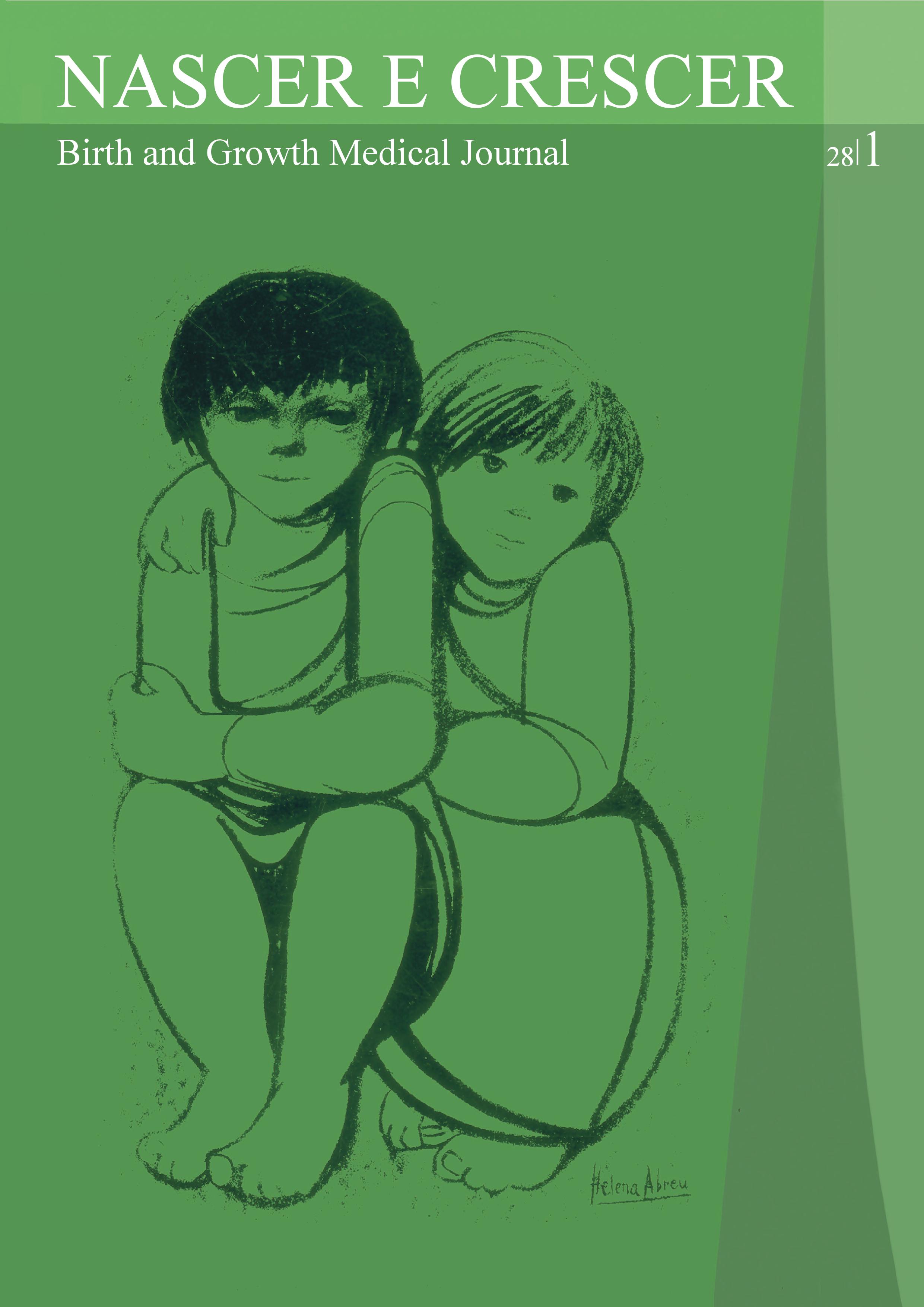Síndrome de junção ureteropélvica: três casos clínicos com início dos sintomas na adolescência
DOI:
https://doi.org/10.25753/BirthGrowthMJ.v28.i1.13536Palavras-chave:
adolescência, hidronefrose, obstrução ureteralResumo
A Síndrome de Junção Ureteropélvica (SJUP) é definida como obstrução ao fluxo de urina na transição entre a pelve renal e o ureter e manifesta-se por dilatação do trato urinário (DTU), anteriormente designada hidronefrose. Esta condição pode ser congénita ou adquirida. A maioria dos casos de DTU são diagnosticados na ecografia pré-natal, mas alguns casos são detetados mais tarde. Na adolescência, as manifestações clínicas incluem dor abdominal ou lombar intermitente, hematúria, nefrolitíase, infeção do trato urinário, deterioração da função renal ou hipertensão arterial. O exame de imagem de escolha para diagnosticar DTU é a ecografia. O renograma permite identificar os casos de SJUP. Os objetivos do tratamento são prevenir a deterioração da função renal e controlar os sintomas. O tratamento conservador é prioritário, mas pode ser necessária correção cirúrgica (pieloplastia). São apresentados três casos clínicos com apresentação dos primeiros sintomas de doença na adolescência. O primeiro caso refere-se a um adolescente de 14 anos com dor abdominal inicialmente interpretada como apendicite aguda; o segundo, a uma adolescente saudável de 15 anos com queixas de disúria e dor lombar; e o terceiro, a uma adolescente de 15 anos saudável, com diagnóstico pré-natal de dilatação uretero-pélvica esquerda, sem outros antecedentes de relevo, com dor lombar à esquerda, disúria e febre.
Conclusão: É necessário um alto grau de suspeição para incluir a SJUP no diagnóstico diferencial da dor lombar e/ou abdominal em adolescentes.
Downloads
Referências
Hashim H, Woodhouse CRJ. Ureteropelvic Junction Obstruction. Eur Urol Suppl 2012; 11:25-32. DOI: 10.1016/j.eursup.2012.01.004
Baskin LS. UpToDate. Congenital ureteropelvic junction obstruction. Available at: https://www.uptodate.com/contents/congenital-ureteropelvic-junction-obstruction?source=search_result&search=Congenital+ureteropelvic+junction+obstruction&selectedTitle=1%7E27. Accessed September 9, 2016.
Chen F. Genetic and developmental basis for urinary tract obstruction. Pediatr Nephrol 2009;24:1621-1632. DOI:10.1007/s00467-008-1072-y.
Poudel A, Afshan S, Dixit M. Congenital Anomalies of the Kidney and Urinary Tract. NeoReviews 2016;17:e18-e27. DOI: 10.1542/neo.17-1-e18
Alberti C. Congenital ureteropelvic junction obstruction: physiopathology, decoupling of tout court pelvic dilatation-obstruction semantic connection, biomarkers to predict renal
damage evolution. Eur Rev Med Pharmacol Sci 2012; 16: 213-219.
Lee H, Han SW. Ureteropelvic Junction Obstruction: What We Know and What We Don’t Know. Korean J Urol 2009;50:423-431. DOI:10.4111/kju.2009.50.5.423
Rosenblum,ND. UpToDate. Evaluation of congenital anomalies of the kidney and urinary tract (CAKUT). Available at: https://www.uptodate.com/contents/evaluation-of-congenital-anomalies-of-the-kidney-and-urinary-tract-cakut?source=search_result&search=Evaluation+of+congenital+anomalies+of+the+kidney+and+urinary+tract+%28CAKUT%29.&selectedTitle=2%7E98. Accessed September 9, 2016.
Trnka P, Hiatt MJ, Tarantal AF, et al. Congenital urinary tract obstruction: defining markers of developmental kidney injury. Pediatr Res 2012;72(5):446-454. DOI:10.1038/pr.2012.113
Piscitelli A, Galiano R, Serrao F, et al. Which cystography in the diagnosis and grading of vesicoureteral reflux? Pediatr Nephrol 2008; 23:107–110. DOI 10.1007/s00467-007-0651-7
Downloads
Publicado
Como Citar
Edição
Secção
Licença
Copyright e Direitos dos Autores
Todos os artigos publicados na Revista Nascer e Crescer – Birth and Growth Medical Journal são de acesso aberto e cumprem os requisitos das agências de financiamento ou instituições académicas. Relativamente à utilização por terceiros a Nascer e Crescer – Birth and Growth Medical Journal rege-se pelos termos da licença Creative Commons "Atribuição - Uso Não-Comercial - (CC-BY-NC)"".
É da responsabilidade do autor obter permissão para reproduzir figuras, tabelas, etc. de outras publicações.
Juntamente com a submissão do artigo, os autores devem enviar a Declaração de conflito de interesses e formulário de autoria. Será enviado um e-mail ao autor correspondente, confirmando a receção do manuscrito.
Os autores ficam autorizados a disponibilizar os seus artigos em repositórios das suas instituições de origem, desde que mencionem sempre onde foram publicados e de acordo com a licença Creative Commons.


